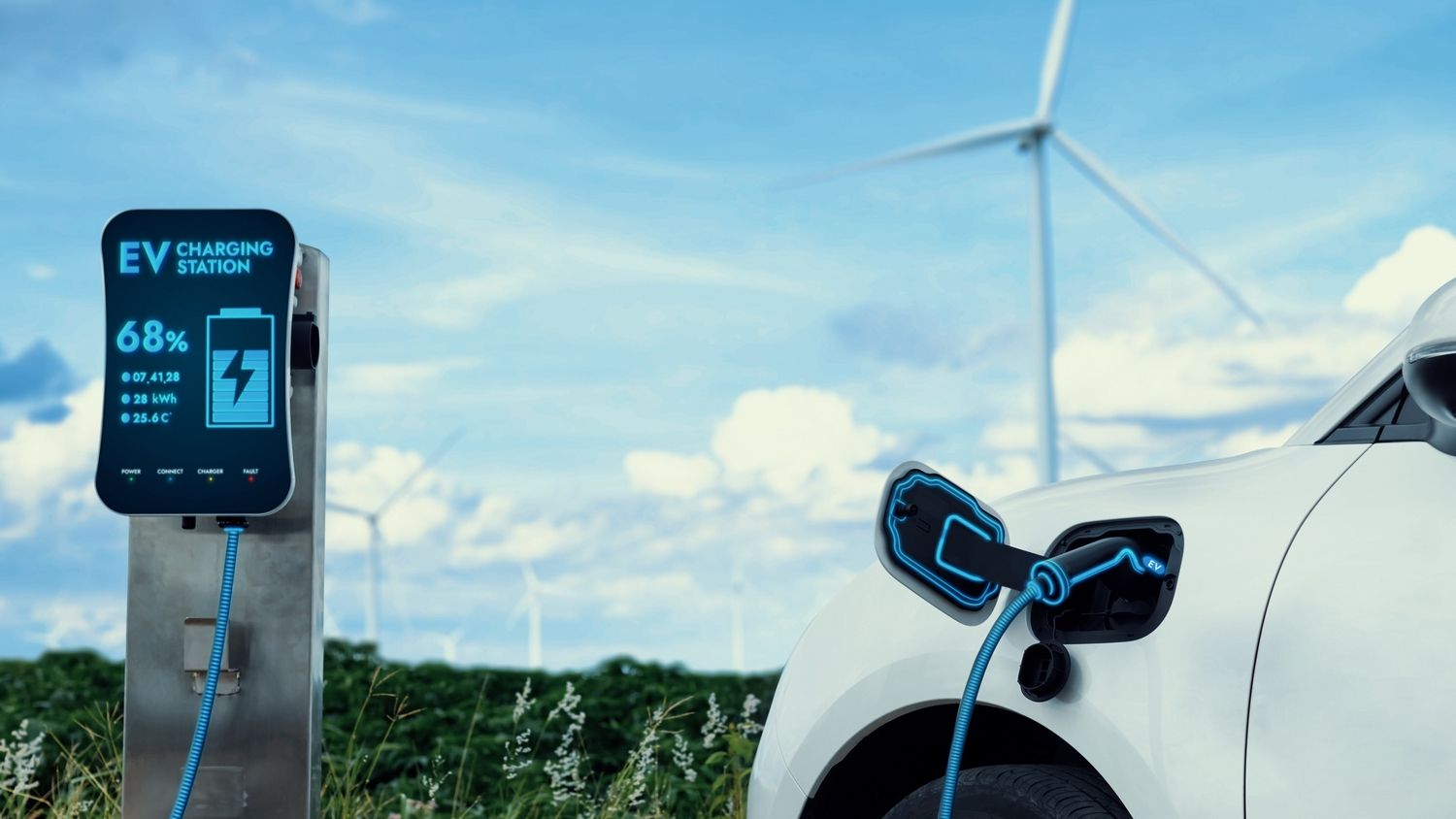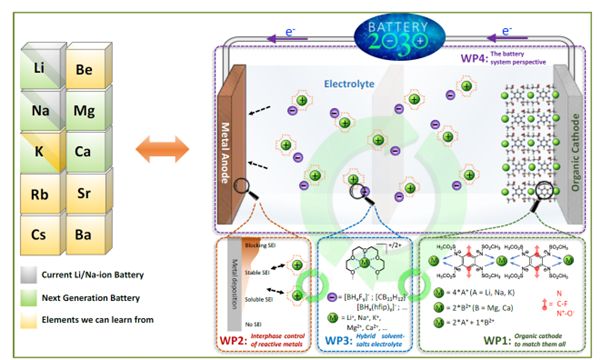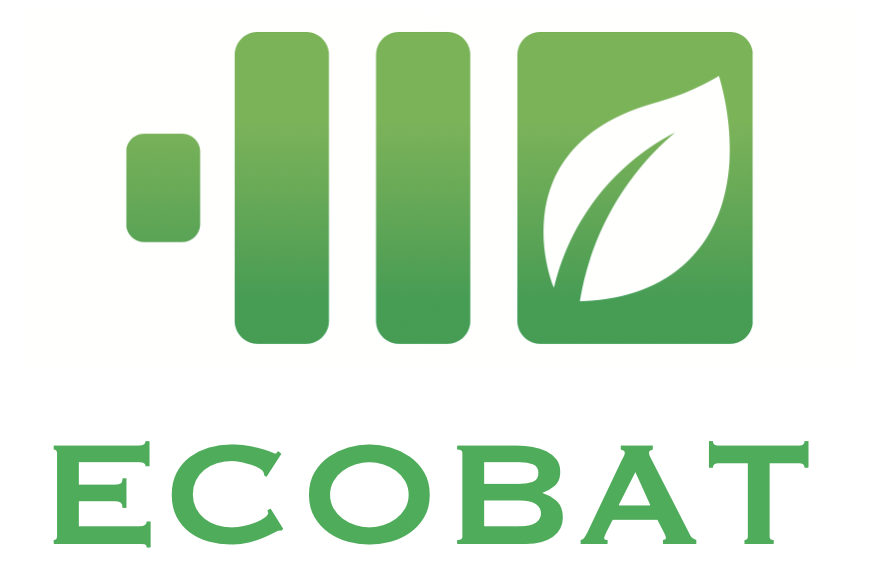EOS – ECOBAT
ECOBAT: Electrocoordination chemistry of s-block elements in organic media for future batteries
About Ecobat
State of the art
Batteries are one of the key enabling technologies to transition to a climate-neutral society by 2050. Since their market introduction in 1991, lithium-ion batteries (LIBs) have developed into a very mature technology and are currently used in a multitude of applications including electric vehicles, residential energy storage and electrical appliances. While the established chemistries and cell architectures for LIBs provide acceptable power and energy densities, these are unlikely to meet the foreseen performance, cost, material sourcing and scale objectives required for the largescale applications such as e-mobility and power grids.

Alternative battery technologies have thus emerged, fueled by the debate on the sustainability of current LIB technologies and the supply risk of future raw materials. The energy storage metrics of the proposed alternatives are suggested to be at least comparable, and in some cases to outperform those of LIBs. However, these remain rough estimates for many of the proposed post-LIB technologies, mainly because practical cells are still difficult to build for now (e.g. Li-O2 or Ca-metal batteries), and a sound, unbiased evaluation remains elusive. For some technologies, these estimates are merely hypothetical, as reliable electrode materials are not even available.
Metal-anode batteries (MABs) have received significant attention during the last decade, as they have the potential to deliver breakthroughs in energy density, radically leap-frogging state-of-the art LIBs. Monovalent (Li and Na) and divalent (Mg and Ca) based MABs have been in the picture. However, the anticipated benefits in terms of energy, safety and recyclability of these metals in batteries should not be taken for granted and, therefore, merit further scrutiny. One, largely underexplored aspect comprises the costs and safety concerns in handling highly-reactive metal anodes in practical battery assembly lines. Some are so reactive (e.g. K, Ca) that even the established methods in industrial dry rooms cannot be applied, casting doubt on their practical implementation. Driving these concepts forward, anode-free cells have also been suggested as practical alternatives to overcome this problem. However, major challenges persist.
The anticipated energy density of s-block metal-anode batteries (e.g. Li vs Na vs K vs Mg vs Ca) remains confusing. Despite huge research efforts, it remains difficult to compare the performance of the s-block elements in future batteries. This is due to the sheer lack of sound methodologies that allow for a non-biased analogy. Despite comparisons being attempted, these remain based on unproven hypotheses, and on electrode materials that still need to be developed and validated.
What
Objective
The overarching ECOBAT objective: design, build & test prototype organic cathode – Li-, Na-, K-, Mg-, Ca-metal cells, but also anode-free cells with high energy and efficiency. Realization of competitive metal-anode batteries (MABs) requires:
- fully-reversible metal anodes;
- high-voltage, high-capacity cathodes that store non-complexed metal ions;
- an electrolyte that fulfills the two previous requirements.
ECOBAT has the capacity to tackle these three essential aspects, exploiting distinct PI’s perspectives, towards the overarching goal of Li, Na, K, Mg, Ca MAB prototype configurations in view of the assessment of fundamental limits and the comparison of practical electrochemical characteristics. Moreover, with our unique expertise on organic Li-, Na-, K-, Mg-, Ca-ion cathodes, we also challenge the anode-free cell design, which is the holy grail of the battery development research as it paves the way for the highest energy densities and the easiest and most cost-efficient assembly process.

how
Research methodology and workplan
ECOBAT consists of 6 interconnected Work Packages (WP):
- WP1 targets the design and synthesis of innovative organic Li-, Na-, K-, Mg-, Ca-ion cathodes, along with fundamental studies of cation storage and diffusion.
- WP2 scrutinizes the target metal interfaces and their reactivity, proposes innovative artificial SEI developments, as well as studies the nucleation and deposition of the s-block metals on different current collector substrates.
- WP3 targets the advanced design, prediction and formulation of the electrolyte, with a central focus on anion chemistries, to cope with WP1 and WP2 developments.
- Finally, WP4 applies the key findings of WP1-3 to build lab-scale prototype cells (metal-anode & anode-free configurations), allowing to assess their energy-storage performances under relevant conditions.
- WP5 organizes the communication, dissemination and exploitation of project result.
- WP6 includes all the project management.
The proposed toolbox in ECOBAT ranges from computational design to advanced materials – electrolyte – electrode synthesis and engineering, complemented by operando studies, all pushing the knowledge beyond the current limits. ECOBAT is first of all fundamental in nature: no energy metrics or performances are being targeted as our intention at this stage is to explore the fundamental aspects of the proposed hypotheses. However, while the project aims to trigger a multitude of high-impact scientific publications, patenting and initiation of bilateral projects with academic and industrial battery actors across the Europe are in scope as well.

result
IMPACT
ECOBAT will provide impact beyond the electrochemistry and energy-storage field & community:
- ECOBAT stretches the boundaries of theoretical chemistry approaches and methods in order to be able to treat more realistic and complex systems (e., more than one aggregate state at the same time: interfaces or surface phenomena, or growth phenomena) with an accuracy beyond classical force-field methods. Complementary to this, faster and more efficient simulation techniques and methods that describe growth phenomena are developed.
- ECOBAT provides vital insights into the coordination chemistry of s-block elements, while testing thermodynamical frameworks for electrolytes with non-conventional anions in organic solvents. Learning about solvent-solute interaction can be related to and aid the understanding of technical processes in recycling and extraction. The theoretical methods able to describe growth phenomena will have an impact on pharmaceutical sciences where crystallization is a very important task.
- The developments of the coordination polymer organic cathodes will provide novel insights into the coordination and reticular chemistry design, synthesis and materials properties.
- New analysis techniques, experimental skills, and modelling knowledge will be gained and developed, that can serve other researchers in the involved groups and in the broader research community.

who
Consortium
SOLVOMET – KU Leuven
BINNEMANS Koen [Spokesperson-coordinator, Principal Investigator]
Chemistry and materials for energy lab (NRJ) – Université Catholique de Louvain
VLAD Alexandru [Principal Investigator]
Surface and Interface Engineered Materials (SIEM) – KU Leuven
FRANSAER Jan [Principal Investigator]
Laboratory of Theoretical chemistry (LCT) – Université de Namur
CHAMPAGNE Benoît [Principal Investigator]
Kirchner group of the Mulliken Center for Theoretical Chemistry – University of Bonn
KIRCHNER Barbara [Principal Investigator]

help
Funding
This project (EOS number: 40007515) has received funding from the FWO and F.R.S.-FNRS under the Excellence of Science (EOS) programme. ECOBAT project is running from January 1, 2022 to December 31, 2025.

Acknowledgment
This project (EOS number: 40007515) has received funding from the FWO and F.R.S.-FNRS under the Excellence of Science (EOS) programme
